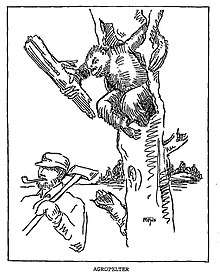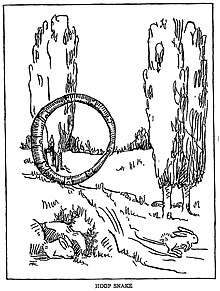Fearsome critters
In early lumberjack folklore, fearsome critters are fantastical beasts that were said to inhabit the frontier wilderness of North America.[1][2][3]
Origins
Fearsome critters were an integral part of oral tradition in North American lumber camps during the turn of the 20th century,[1] principally as a means to pass time (such as in tall tales)[4] or as a jest for hazing newcomers.[5] In a typical fearsome critter gag, a person would casually remark about a strange noise or sight they encountered in the wild; subsequently, another accomplice would join in. Meanwhile, an eavesdropper would begin to investigate, as Henry H. Tryon recorded in his book, Fearsome Critters (1939) —
Sam would lead with a colorful bit of description, and Walter would follow suit with an arresting spot of personal experience, every detail being set forth with the utmost solemnity, and with exactly the correct degree of emphasis. At the end, so deftly had the cards been played that the listener was completely convinced of the animal's existence. This method of presentation is widely used. For the best results, two narrators who can "keep the ball in the air" are necessary, and perhaps an occasional general question is tossed to someone in the audience, such inquires being invariably accorded a grave, corroborative nod.[5]
Lumberjacks, who regularly traveled between camps, would stop to swap stories, eventually disseminating these myths across the continent.[4] Many fearsome critters were simply the products of pure exaggeration; while a number, however, were used either seriously or jokingly as explanations for unexplained phenomena. For example, the hidebehind served to account for loggers who failed to return to camp,[6][7] while the treesqueak offered justification for strange noises heard in the woods.[5] A handful mirrored descriptions of actual animals. The mangrove killifish, which takes up shelter in decaying branches after leaving the water,[8] exhibits similarities to the upland trout, a legendary fish purported to nest in trees.[9] In addition, the story of the fillyloo, about a mythical crane that flies upside-down, may have been inspired by observations of the wood stork, a bird that has been witnessed briefly flying in this manner.[10] In particular instances more elaborate ruses were created using taxidermy[11] or trick photography.[12]
Attributes
The character of the fearsome critters themselves was usually more comical than frightful.[1] Often the greater emphasis is placed on behavioral traits with little or no detail mentioned on their appearance, as in the cases of the hidebehind, teakettler,[13] squidgicum-squee,[14] and hangdown.[6] The tendency to description of behavior without image is used to eerie literary effect by Manly Wade Wellman in employing a number of fearsome critters in his 1952 science fiction folk tale "The Desrick on Yandro," as well as commenting specifically on the lack of physical description for one of the beasts: "The Behinder flung itself on his shoulders. Then I knew why nobody's supposed to see one. I wish I hadn't. To this day I can see it, as plain as a fence at noon, and forever I will be able to see it. But talking about it's another matter. Thank you, I won't try."
Some fearsome critters like flittericks or the goofus[7] appeared to be ordinary animals that just behaved out of the ordinary. The more physically emphasized and improbable creatures seem to be distinguished by how far the storyteller could push the boundaries of biomechanics. Both the tripodero[6] and snoligoster[4] demonstrate facets more in common with mechanical apparatuses than animals, and the hugag and sidehill gouger[5] seem to be more a play on applied physics than fanciful inspiration. While much of the literature that has been written on the subject echoes a naturalist's perspective, commonly specifying a range of distribution, behavioral habits, and physical appearance,[4][5][9] many of these myths were never widespread. It is common to find a lack of consensus on a specific fearsome critter, if not clear contradictions. To illustrate, the wampus cat differs widely between Vance Randolph's We Always Lie to Strangers and Henry H. Tryon's Fearsome Critters, with Tryon describing a cat with pantographic forelimbs[5] and Randolph portraying it as a supernatural, aquatic panther.[10]
List

Beasts
- Agropelter, a beast which amuses itself by hurling twigs and tree branches at passers by.[4]
- Axehandle hound, reputedly subsisted on axe handles left unattended; mentioned in Jorge Luis Borges' Book of Imaginary Beings.[13]
- Ball-tailed cat, a feline similar to a mountain lion, except with a long tail with a bulbous end used for striking its prey.
- Cactus cat, feline of the American southwest with hair like thorns that intoxicates itself by the consumption of cactus water.[4]
- Dungavenhooter, a crocodile creature with no mouth, instead having huge nostrils. Uses its tail to pound loggers into a gas, which it then inhales for sustenance.[5]
- Funeral Mountain Terrashot, casket-shaped creature that lives in the mountains until they migrate into the desert, where they explode from the heat leaving grave shaped holes.
- Glawackus, a fierce brute resembling a combination of a panther, lion, and a bear.
- Goofus bird, a backwards-flying bird that builds its nest upside-down.[13]
- Gumberoo, rare hairless bear like creature with skin that is nearly invulnerable, repelling all attacks except fire which will cause the gumberoo to combust in a massive explosion.
- Hidebehind, a brute which would seize unwary lumberjacks and devour them, and was said to be so swift that it could hide behind the nearest tree before a man turned around.[5]
- Hodag, a favorite varmint of the Wisconsin swamps affixed with horns and spikes, complemented by a maniacal grin.[13]
- Jackalope, a rabbit with the antlers of an antelope or deer.[9]
- Jersey Devil, a predatory creature said to terrorize livestock in the pines of Southern New Jersey. Often described as winged and bipedal, and sometimes connected to witchcraft and devil worship.
- Rumtifusel, creature camouflaged as a fur coat. When a passerby picks the coat up it envelops and devours them.
- Sidehill gouger, a beast legged for hillsides having legs on one side taller than the other, thus always traveling in a circular path.[9]
- Skunk ape, a hominid said to inhabit Florida, characterized by its unpleasant stench.[15]
- Snallygaster, a dragon-like beast said to inhabit the hills surrounding Washington and Frederick Counties of Maryland.
- Snipe, the subject of a famous ruse of many a camp consisting of a wild goose chase for the animal.[5]
- Splintercat, a legendary cat in the Pacific Northwest that uses his incredible speed and stiff forehead to smash into large trees, knocking the branches off and withering the trunks.
- Squonk, the most melancholy of creatures. Because of its deformed countenance, it refuses contact with all life and will dissolve in its own tears if ever gazed upon.[4]
- Teakettler, a small vermin which makes a noise like the sound of a tea kettle.[13]
- Tripodero, a creature with two telescopic legs and a tail for balancing. When it spots prey it elevates to the proper height and fires clay projectiles from its mouth.
- Tsul 'Kalu, a large bigfoot with red eyes. It is said to have the power to hypnotize and read thoughts.
- Wampus cat, a large phantom panther[10] who some say heralds death with its call.
- Whirling Whimpus, a creature that spins so fast that it becomes invisible and creates a droning sound, luring animals and passerby to be reduced to treacle by its paddle-like arms.
.jpg)
Fish
- Fur-bearing trout, a species of trout which grows a thick coat of fur for warmth in its cold climate.[16]

Serpents
- Hoop snake, a snake which bites its tail to enable it to roll like a wheel.[10]
- Joint snake, a snake that can reassemble itself after being cut to pieces or break apart when hit with something.
- Spreading adder, a snake that flattens out when scared and has an incurable bite. The behaviour of flattening one's body when scared can be observed in a few existing snakes, such as the ninia maculata[17] and the malasian pipe snake.[18]
See also
References
Footnotes
- 1 2 3 Dorson, Richard M. Man and Beast in American Comic Legend. (Bloomington, IN: Indiana Univ. Press, 1982.)
- ↑ Leach, Maria. Funk & Wagnalls Standard Dictionary Of Folklore, Mythology and Legend. (New York: Funk & Wagnalls Company, 1949.)
- ↑ South, Malcolm. Mythical and Fabulous Creatures: A Source Book and Research Guide. (Westport, CT: Greenwood Publishing Group, 1984.)
- 1 2 3 4 5 6 7 Cox, William T. with Latin Classifications by George B. Sudworth. Fearsome Creatures of the Lumberwoods. Washington, D.C.: Judd & Detweiler Inc., 1910
- 1 2 3 4 5 6 7 8 9 Tryon, Henry Harrington. Fearsome Critters. (Cornwall, NY: Idlewild Press, 1939)
- 1 2 3 Brown, C.E. Paul Bunyan Natural History. (Madison: self-published, 1935.)
- 1 2 Cohen, Daniel. Monsters, Giants, and Little Men from Mars: An Unnatural History of the Americas. (New York: Doubleday, 1975)
- ↑ Derbyshire, David. (2007). "The fish that can survive for months in a tree." Retrieved March 08, 2011, from MailOnline. Web site: http://www.dailymail.co.uk/news/article-488193/The-fish-survive-months-tree.html
- 1 2 3 4 Wyman, Walker D. Mythical Creatures of the USA and Canada. (River Falls, WI: Univ of Wisconsin Riverfalls Press,1978.)
- 1 2 3 4 Randolph, Vance. We Always Lie to Strangers: Tall Tales from the Ozarks. (New York: Columbia University Press, 1951.)
- ↑ Wisconsinosity. (2010). "Barron County: The Friendly Buckhorn Bar." Retrieved March 09, 2011, from Wisconsinosity.com. Web site: http://www.wisconsinosity.com/Barron/barron.htm
- ↑ Wisconsin Historical Society. (2011). "Larger Than Life: Tall-Tale Postcards." Retrieved March 09, 2011, from Wisconsin Historical Society. Web site: http://www.wisconsinhistory.org/whi/feature/talltales/
- 1 2 3 4 5 Borges, Jorge Luis; Guerrero, Margarita. Book of Imaginary Beings. (New York: Dutton, 1969.)
- ↑ Schwartz, Alvin. Kickle Snifters and Other Fearsome Critters. (Binghamton, NY: Harpercollins Juvenile Books, 1978.)
- ↑ Lennon, Vince (2003-10-22). "Is a Skunk Ape Loose in Campbell County?". WATE 6 News. WorldNow and WATE. Retrieved 2006-12-23.
- ↑ Fellowship of Fur-Bearing Fish. (2011). "Myth or Marvel?: The Fur-Bearing Trout." Retrieved March 09, 2011, from Furbearingtrout.com. Web site: http://www.furbearingtrout.com
- ↑ This Snake Flattens Itself to Hide From Danger, retrieved 2018-04-20
- ↑ Khanna, D. R. (2004). Biology of Reptiles. Discovery Publishing House. ISBN 9788171419074.
Notations
- Boatright, Mody C. Tall Tales from Texas Cow Camps. (Dallas: The Southwest Press, 1934)
- Botkin, B.A. (Ed.) A Treasury of American Folklore. (New York: Crown Publishers, 1955), The *American People: Stories, Legends, Tales, Traditions and Songs. (New Jersey: Transaction Publishers, 1977)
- Davidson, Levette Jay & Forrester Blake (eds.). Rocky Mountain Tales. (Tulsa: University of Oklahoma Press, 1947)
- Leach, Maria (ed.) Funk & Wagnall's Standard Dictionary of Folklore, Mythology and Legend. (New York: Harper & Row, 1972)
- MacDougall, Curtis D. Hoaxes. (New York: Dover Publications, Inc., 1958)
- Cohen, Daniel. Monsters, Giants, and Little Men from Mars: An Unnatural History of the Americas. (New York: Doubleday, 1975)